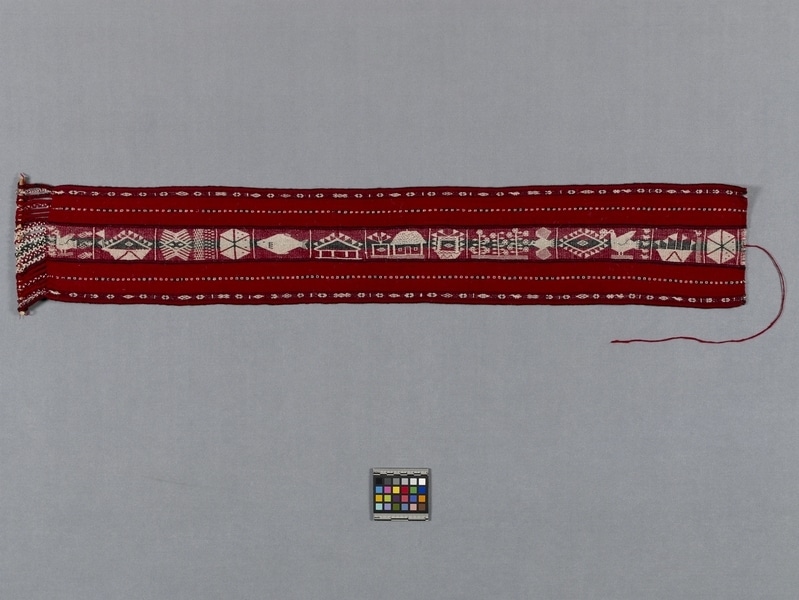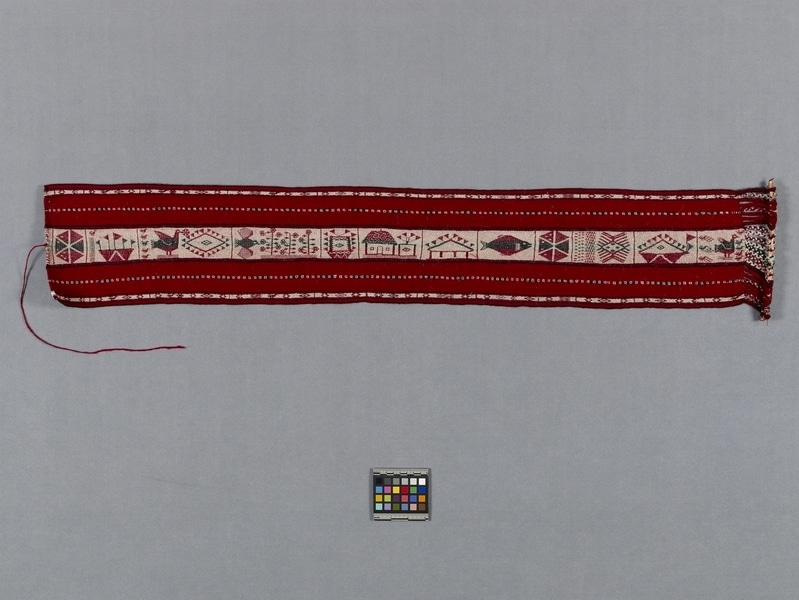Belt Item Number: Sf1013 from the MOA: University of British Columbia


Description
Red belt, firmly woven, with five parallel patterned bands. The centre band is the widest, with geometric shapes, bird, fish, boat, and building motifs in red and green, on white ground. Middle band is flanked by two narrow strips of white squares on alternating red and green sections. The narrow bands near the edges have small scale geometric shapes and bird motifs, in red and green, on white ground. One end has short braided looped fringe, which have a wooden stick slipped through the end loops. The other end has a single re-plied cord looped into the fabric at the centre of the design panel.
History Of Use
The 'calendar' belt appears to be a recent development, perhaps in response to the interest of foreigners in the woven patterns and their meanings. The linear lay-out, the division into 12 parts and the beginning with the January suggests a Gregorian calendar model rather than an indigenous one.
Specific Techniques
Yarns are z spun and plied 2 s. The white yarns are handspun alpaca and the coloured yarns are synthetic and wool yarns that have been re-twisted to tighten the ply. Weave structures are warp-faced plain weave a complementary warp weave with 3 span floats aligned in alternate pairs, and a float weave. The belt is woven to its finished dimensions. The warps in the terminal area are grouped and braided in 3 strand oblique interlacing with the warp loops intact.
Narrative
Bought from Sebastian Marca Yucra, 52 (c 1987), whose second wife, Agustina Huatta Flores, made it. Sebastian had to go Puno to get it back from someone who was displaying it. Sebastian claims this belt shows how the Taquile people, from very ancient times onward, marked the annual cycle. Agustina says she learned from her grandmother. Her cousins, including the wife of Alejandro Flores, also knew the symbols and how to weave them. Only a few families on Taquile claim to know how to make the calendar belt.
Iconographic Meaning
Said to be a belt to 'count the year'. Each of the 12 sections refers to a month of the year through a reference to the agricultural cycle or fiesta cycle. The 6 part circle with dots in 3 sections refers to the division of land and the rotation of crops. Potatoes, oca, and grain are grown in the first, second and third years of the six year cycle (see Zorn, 1987 and Fini, 1985).
Cultural Context
calendar
Item History
- Made by Agustina Huatta Flores (Maker) in Taquile, Puno, Peru during August 1987
- Collected by Mary Frame during 1987
- Owned by Mary Frame before November 3, 1987
- Received from Mary Frame (Seller) and Museum of Anthropology Shop Volunteers (Funding source) on November 3, 1987
What
- Name
- Belt
- Identification Number
- Sf1013
- Type of Item
- belt
- Material
- synthetic fibre, alpaca wool fibre, wool fibre, fibre, wood and dye
- Manufacturing Technique
- retwisted, woven and braided
- Overall
- height 17.3 cm, width 107.5 cm
Who
- Culture
- Quechua
- Creator
- Agustina Huatta Flores (Maker)
- Field Collector
- Mary Frame
- Previous Owner
- Mary Frame
- Received from
- Mary Frame (Seller) and Museum of Anthropology Shop Volunteers (Funding source)
Where
- Holding Institution
- MOA: University of British Columbia
- Made in
- Taquile, Puno, Peru
When
- Creation Date
- during August 1987
- Collection Date
- during 1987
- Ownership Date
- before November 3, 1987
- Acquisition Date
- on November 3, 1987
Other
- Item Classes
- textiles
- Condition
- good
- Accession Number
- 1274/0030